warning Mercury Milan Hybrid 2010 Owner's Manuals
[x] Cancel search | Manufacturer: MERCURY, Model Year: 2010, Model line: Milan Hybrid, Model: Mercury Milan Hybrid 2010Pages: 329, PDF Size: 2.39 MB
Page 229 of 329
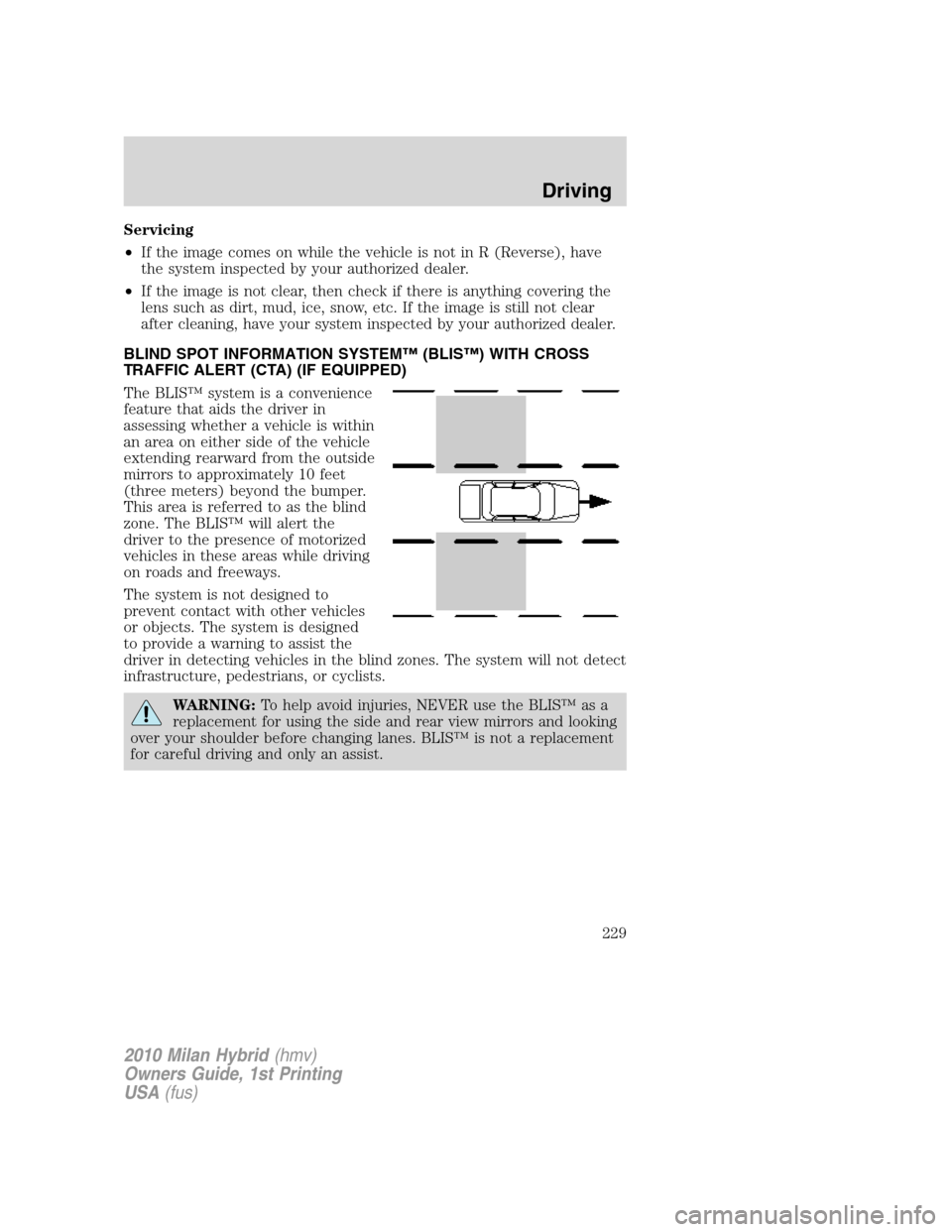
Servicing
•If the image comes on while the vehicle is not in R (Reverse), have
the system inspected by your authorized dealer.
•If the image is not clear, then check if there is anything covering the
lens such as dirt, mud, ice, snow, etc. If the image is still not clear
after cleaning, have your system inspected by your authorized dealer.
BLIND SPOT INFORMATION SYSTEM™ (BLIS™) WITH CROSS
TRAFFIC ALERT (CTA) (IF EQUIPPED)
The BLIS™ system is a convenience
feature that aids the driver in
assessing whether a vehicle is within
an area on either side of the vehicle
extending rearward from the outside
mirrors to approximately 10 feet
(three meters) beyond the bumper.
This area is referred to as the blind
zone. The BLIS™ will alert the
driver to the presence of motorized
vehicles in these areas while driving
on roads and freeways.
The system is not designed to
prevent contact with other vehicles
or objects. The system is designed
to provide a warning to assist the
driver in detecting vehicles in the blind zones. The system will not detect
infrastructure, pedestrians, or cyclists.
WARNING:To help avoid injuries, NEVER use the BLIS™ as a
replacement for using the side and rear view mirrors and looking
over your shoulder before changing lanes. BLIS™ is not a replacement
for careful driving and only an assist.
2010 Milan Hybrid(hmv)
Owners Guide, 1st Printing
USA(fus)
Driving
229
Page 230 of 329
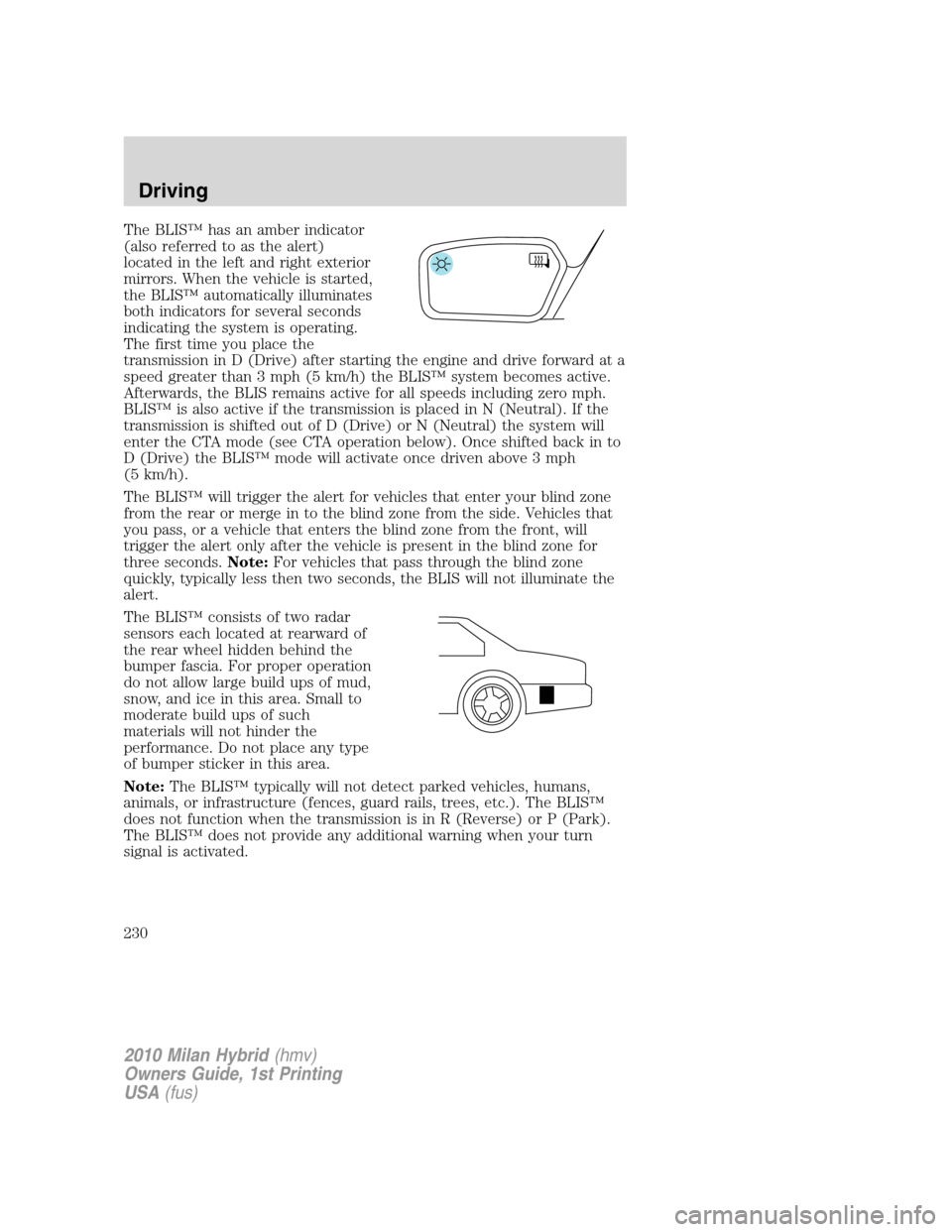
The BLIS™ has an amber indicator
(also referred to as the alert)
located in the left and right exterior
mirrors. When the vehicle is started,
the BLIS™ automatically illuminates
both indicators for several seconds
indicating the system is operating.
The first time you place the
transmission in D (Drive) after starting the engine and drive forward at a
speed greater than 3 mph (5 km/h) the BLIS™ system becomes active.
Afterwards, the BLIS remains active for all speeds including zero mph.
BLIS™ is also active if the transmission is placed in N (Neutral). If the
transmission is shifted out of D (Drive) or N (Neutral) the system will
enter the CTA mode (see CTA operation below). Once shifted back in to
D (Drive) the BLIS™ mode will activate once driven above 3 mph
(5 km/h).
The BLIS™ will trigger the alert for vehicles that enter your blind zone
from the rear or merge in to the blind zone from the side. Vehicles that
you pass, or a vehicle that enters the blind zone from the front, will
trigger the alert only after the vehicle is present in the blind zone for
three seconds.Note:For vehicles that pass through the blind zone
quickly, typically less then two seconds, the BLIS will not illuminate the
alert.
The BLIS™ consists of two radar
sensors each located at rearward of
the rear wheel hidden behind the
bumper fascia. For proper operation
do not allow large build ups of mud,
snow, and ice in this area. Small to
moderate build ups of such
materials will not hinder the
performance. Do not place any type
of bumper sticker in this area.
Note:The BLIS™ typically will not detect parked vehicles, humans,
animals, or infrastructure (fences, guard rails, trees, etc.). The BLIS™
does not function when the transmission is in R (Reverse) or P (Park).
The BLIS™ does not provide any additional warning when your turn
signal is activated.
2010 Milan Hybrid(hmv)
Owners Guide, 1st Printing
USA(fus)
Driving
230
Page 231 of 329
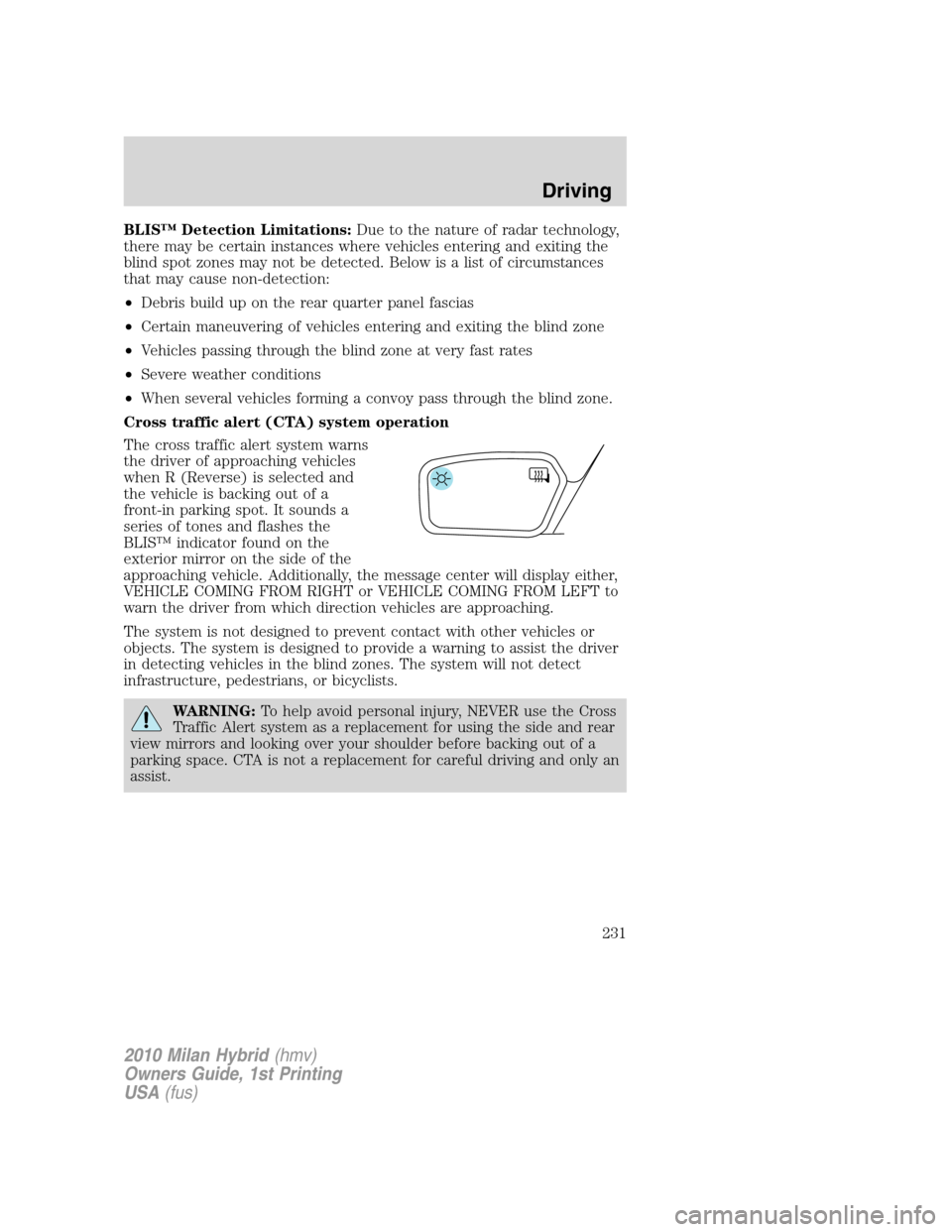
BLIS™ Detection Limitations:Due to the nature of radar technology,
there may be certain instances where vehicles entering and exiting the
blind spot zones may not be detected. Below is a list of circumstances
that may cause non-detection:
•Debris build up on the rear quarter panel fascias
•Certain maneuvering of vehicles entering and exiting the blind zone
•Vehicles passing through the blind zone at very fast rates
•Severe weather conditions
•When several vehicles forming a convoy pass through the blind zone.
Cross traffic alert (CTA) system operation
The cross traffic alert system warns
the driver of approaching vehicles
when R (Reverse) is selected and
the vehicle is backing out of a
front-in parking spot. It sounds a
series of tones and flashes the
BLIS™ indicator found on the
exterior mirror on the side of the
approaching vehicle. Additionally, the message center will display either,
VEHICLE COMING FROM RIGHT or VEHICLE COMING FROM LEFT to
warn the driver from which direction vehicles are approaching.
The system is not designed to prevent contact with other vehicles or
objects. The system is designed to provide a warning to assist the driver
in detecting vehicles in the blind zones. The system will not detect
infrastructure, pedestrians, or bicyclists.
WARNING:To help avoid personal injury, NEVER use the Cross
Traffic Alert system as a replacement for using the side and rear
view mirrors and looking over your shoulder before backing out of a
parking space. CTA is not a replacement for careful driving and only an
assist.
2010 Milan Hybrid(hmv)
Owners Guide, 1st Printing
USA(fus)
Driving
231
Page 233 of 329

CTA Detection Limitations:Due to the nature of radar technology,
there may be certain instances where vehicles entering and exiting the
blind spot zones may not be detected. Below is a list of circumstances
that may cause non detection:
•Debris build up on the rear quarter panel fascias
•The rear quarter panel radar beams are obstructed or partially
obstructed by an adjacently parked vehicle or object.
•Approaching vehicles passing at speeds greater than 15 mph
(24 km/h).
•Severe weather conditions
•Driving in reverse faster than 3 mph (5 km/h).
•Backing out of an angled parking spot.
CTA and Reverse Sensing System (RSS) interaction
CTA works along with the Reverse Sensing System (RSS) (if equipped).
Become familiar with the warning tones of both systems.
BLIS™-CTA on/off and disable operation
The BLIS™ and/or the CTA can be turned off via the message center.
Turning the BLIS™ off does not turn off the CTA and visa versa. If either
the BLIS™ or CTA is turned off, the systems will automatically turn back
on at the next ignition key cycle. When either the BLIS™ or CTA is
turned off, the message center displays BLIND SPOT SYS OFF and/or
CTA SYSTEM OFF. When the BLIS™ or CTA system is off, the driver
will not receive alerts. Refer toMessage Centerin theInstrument
Clusterchapter.
The BLIS™-CTA can be disabled permanently even after an ignition key
cycle. This must be done by your dealership service technician.
Once either of the systems are disabled, enabling must also be performed
at the dealership. When disabled, the message center will display BLIND
SPOT DISABLED and/or CTA DISABLED.
2010 Milan Hybrid(hmv)
Owners Guide, 1st Printing
USA(fus)
Driving
233
Page 234 of 329

BLIS™-CTA fault operation
If the BLIS™-CTA senses a fault on either the left or right sensor, the
BLIS™ alert indicator will go ON and remain ON and the message center
will display BLIND SPOT SYSTEM FAULT or CROSS TRAFFIC SYSTEM
FAULT. For faults that may cause the associated left or right alert
indicator not to illuminate, only the message center faults will occur.
Blocked sensor
An extreme build up of materials on
the left and/or right quarter panel
fascias such as mud or snow can
cause degraded performance of the
BLIS™. Also, heavy rain can cause
the same effect. The BLIS™ can
detect this degraded performance
and issue a blocked warning to the driver via the message center. If
condition is determined by the system, the message center displays
BLIND SPOT NOT AVAILABLE or CROSS TRAFFIC NOT AVAILABLE
warning and the appropriate left and/or right exterior mirror alert
indicator will illuminate. The message center warning may be cleared by
the driver but the exterior mirror alert indicator will remain illuminated.
WARNING:Just prior to the system recognizing a blocked
condition and alerting the driver, the number of missed objects
will increase. To help avoid injuries, NEVER use the BLIS™ as a
replacement for using the side and rear view mirrors and looking over
your shoulder before changing lanes. BLIS™ is not a replacement for
careful driving and only an assist.
Once blockage is removed, the system will require some driving time and
detection of at least two vehicle object prior to realizing it is unblocked,
or the driver can cycle the ignition key. If blocked and the ignition key is
cycled, the system resets to unblocked. If however blockage is still
present after the key cycle, the system will sense again that it is blocked
after driving in traffic.
2010 Milan Hybrid(hmv)
Owners Guide, 1st Printing
USA(fus)
Driving
234
Page 238 of 329

Push in the flasher control and all front and rear direction signals will
flash. Press the flasher control again to turn them off. Use it when your
vehicle is disabled and is creating a safety hazard for other motorists.
Note:With extended use, the flasher may run down your battery.
FUEL PUMP SHUT-OFF
In the event of a moderate to severe collision, this vehicle is equipped
with a fuel pump shut-off feature that stops the flow of fuel to the
engine. Not every impact will cause a shut-off.
Should your vehicle shut off after a collision due to this feature, you may
restart your vehicle by doing the following:
1. Turn the ignition switch to the off position.
2. Turn the ignition switch to the on position.
In some instances the vehicle may not restart the first time you try to
restart and may take one additional attempt.
WARNING:Failure to inspect and if necessary repair fuel leaks
after a collision may increase the risk of fire and serious injury.
Ford Motor Company recommends that the fuel system be inspected
by an authorized dealer after any collision.
FUSES AND RELAYS
Fuses
If electrical components in the
vehicle are not working, a fuse may
have blown. Blown fuses are
identified by a broken wire within
the fuse. Check the appropriate
fuses before replacing any electrical
components.
Note:Always replace a fuse with one that has the specified amperage
rating. Using a fuse with a higher amperage rating can cause severe wire
damage and could start a fire.
15
2010 Milan Hybrid(hmv)
Owners Guide, 1st Printing
USA(fus)
Roadside Emergencies
238
Page 242 of 329
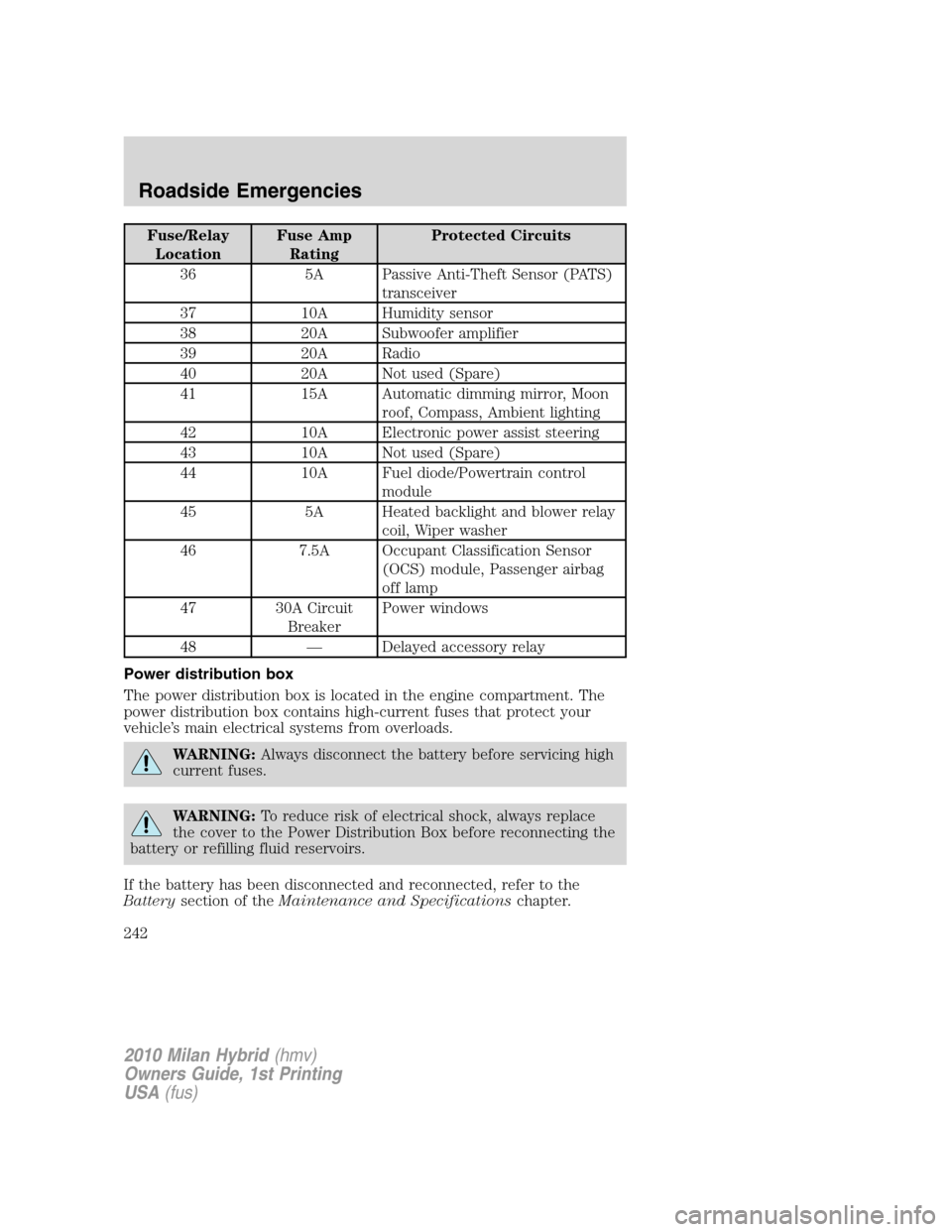
Fuse/Relay
LocationFuse Amp
RatingProtected Circuits
36 5A Passive Anti-Theft Sensor (PATS)
transceiver
37 10A Humidity sensor
38 20A Subwoofer amplifier
39 20A Radio
40 20A Not used (Spare)
41 15A Automatic dimming mirror, Moon
roof, Compass, Ambient lighting
42 10A Electronic power assist steering
43 10A Not used (Spare)
44 10A Fuel diode/Powertrain control
module
45 5A Heated backlight and blower relay
coil, Wiper washer
46 7.5A Occupant Classification Sensor
(OCS) module, Passenger airbag
off lamp
47 30A Circuit
BreakerPower windows
48 — Delayed accessory relay
Power distribution box
The power distribution box is located in the engine compartment. The
power distribution box contains high-current fuses that protect your
vehicle’s main electrical systems from overloads.
WARNING:Always disconnect the battery before servicing high
current fuses.
WARNING:To reduce risk of electrical shock, always replace
the cover to the Power Distribution Box before reconnecting the
battery or refilling fluid reservoirs.
If the battery has been disconnected and reconnected, refer to the
Batterysection of theMaintenance and Specificationschapter.
2010 Milan Hybrid(hmv)
Owners Guide, 1st Printing
USA(fus)
Roadside Emergencies
242
Page 246 of 329
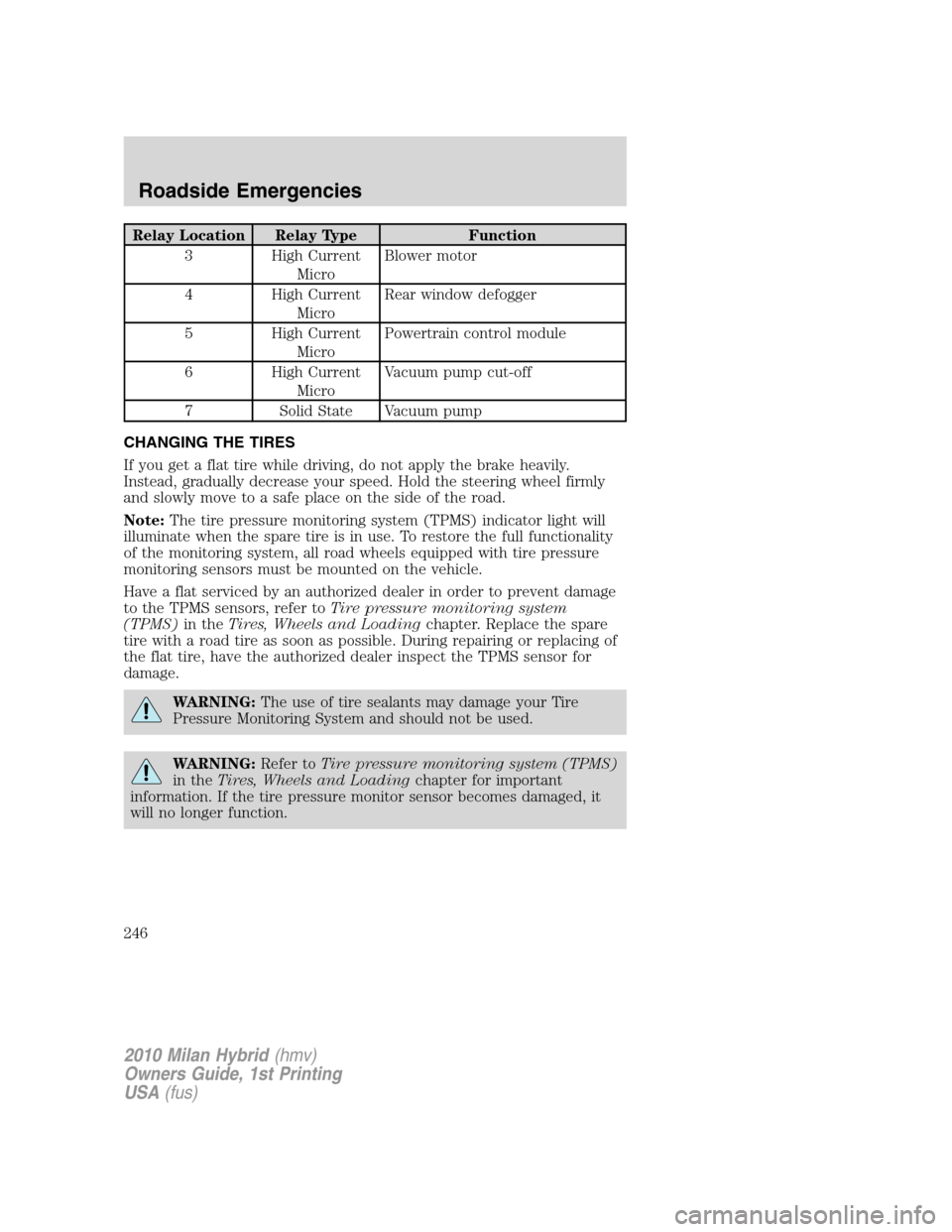
Relay Location Relay Type Function
3 High Current
MicroBlower motor
4 High Current
MicroRear window defogger
5 High Current
MicroPowertrain control module
6 High Current
MicroVacuum pump cut-off
7 Solid State Vacuum pump
CHANGING THE TIRES
If you get a flat tire while driving, do not apply the brake heavily.
Instead, gradually decrease your speed. Hold the steering wheel firmly
and slowly move to a safe place on the side of the road.
Note:The tire pressure monitoring system (TPMS) indicator light will
illuminate when the spare tire is in use. To restore the full functionality
of the monitoring system, all road wheels equipped with tire pressure
monitoring sensors must be mounted on the vehicle.
Have a flat serviced by an authorized dealer in order to prevent damage
to the TPMS sensors, refer toTire pressure monitoring system
(TPMS)in theTires, Wheels and Loadingchapter. Replace the spare
tire with a road tire as soon as possible. During repairing or replacing of
the flat tire, have the authorized dealer inspect the TPMS sensor for
damage.
WARNING:The use of tire sealants may damage your Tire
Pressure Monitoring System and should not be used.
WARNING:Refer toTire pressure monitoring system (TPMS)
in theTires, Wheels and Loadingchapter for important
information. If the tire pressure monitor sensor becomes damaged, it
will no longer function.
2010 Milan Hybrid(hmv)
Owners Guide, 1st Printing
USA(fus)
Roadside Emergencies
246
Page 247 of 329
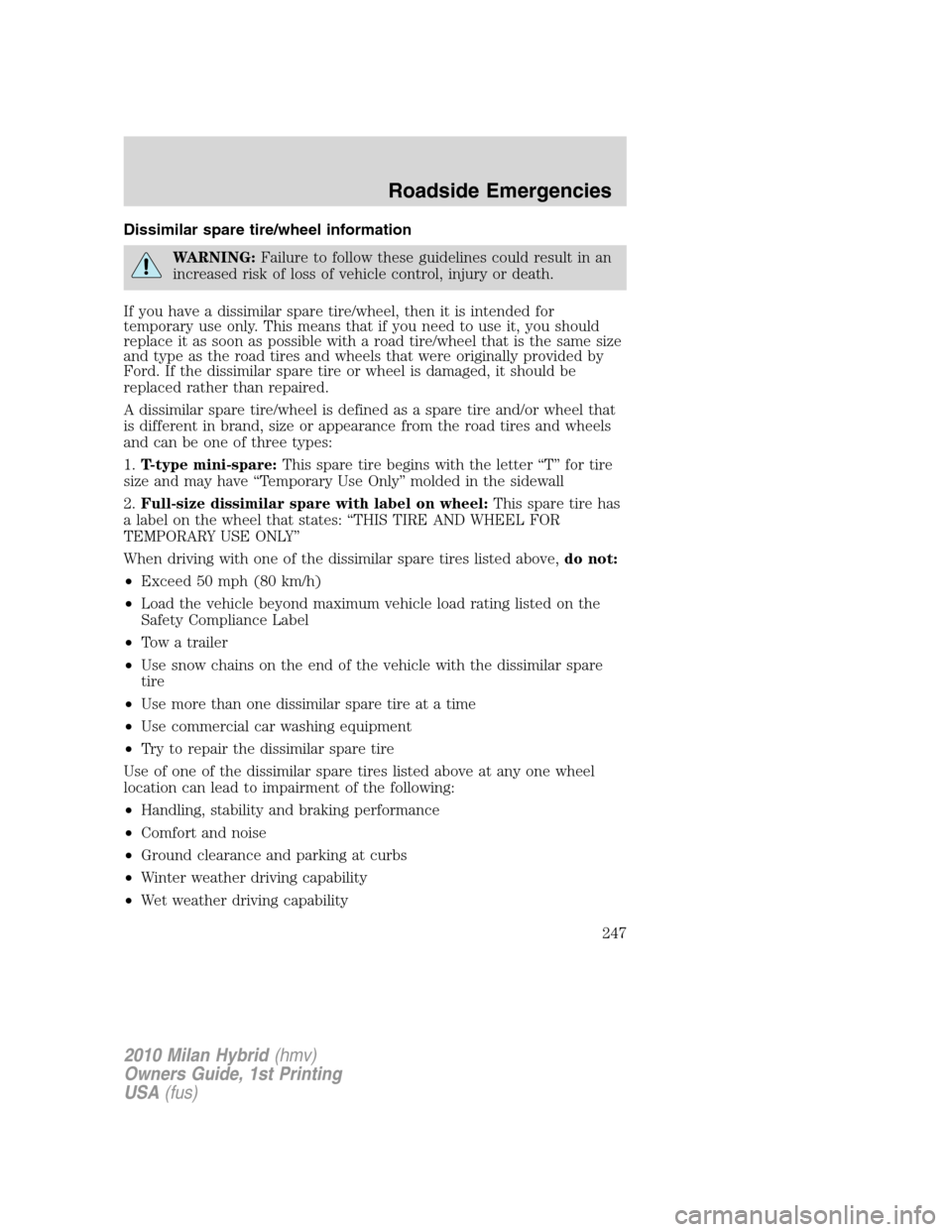
Dissimilar spare tire/wheel information
WARNING:Failure to follow these guidelines could result in an
increased risk of loss of vehicle control, injury or death.
If you have a dissimilar spare tire/wheel, then it is intended for
temporary use only. This means that if you need to use it, you should
replace it as soon as possible with a road tire/wheel that is the same size
and type as the road tires and wheels that were originally provided by
Ford. If the dissimilar spare tire or wheel is damaged, it should be
replaced rather than repaired.
A dissimilar spare tire/wheel is defined as a spare tire and/or wheel that
is different in brand, size or appearance from the road tires and wheels
and can be one of three types:
1.T-type mini-spare:This spare tire begins with the letter “T” for tire
size and may have “Temporary Use Only” molded in the sidewall
2.Full-size dissimilar spare with label on wheel:This spare tire has
a label on the wheel that states: “THIS TIRE AND WHEEL FOR
TEMPORARY USE ONLY”
When driving with one of the dissimilar spare tires listed above,do not:
•Exceed 50 mph (80 km/h)
•Load the vehicle beyond maximum vehicle load rating listed on the
Safety Compliance Label
•Tow a trailer
•Use snow chains on the end of the vehicle with the dissimilar spare
tire
•Use more than one dissimilar spare tire at a time
•Use commercial car washing equipment
•Try to repair the dissimilar spare tire
Use of one of the dissimilar spare tires listed above at any one wheel
location can lead to impairment of the following:
•Handling, stability and braking performance
•Comfort and noise
•Ground clearance and parking at curbs
•Winter weather driving capability
•Wet weather driving capability
2010 Milan Hybrid(hmv)
Owners Guide, 1st Printing
USA(fus)
Roadside Emergencies
247
Page 249 of 329
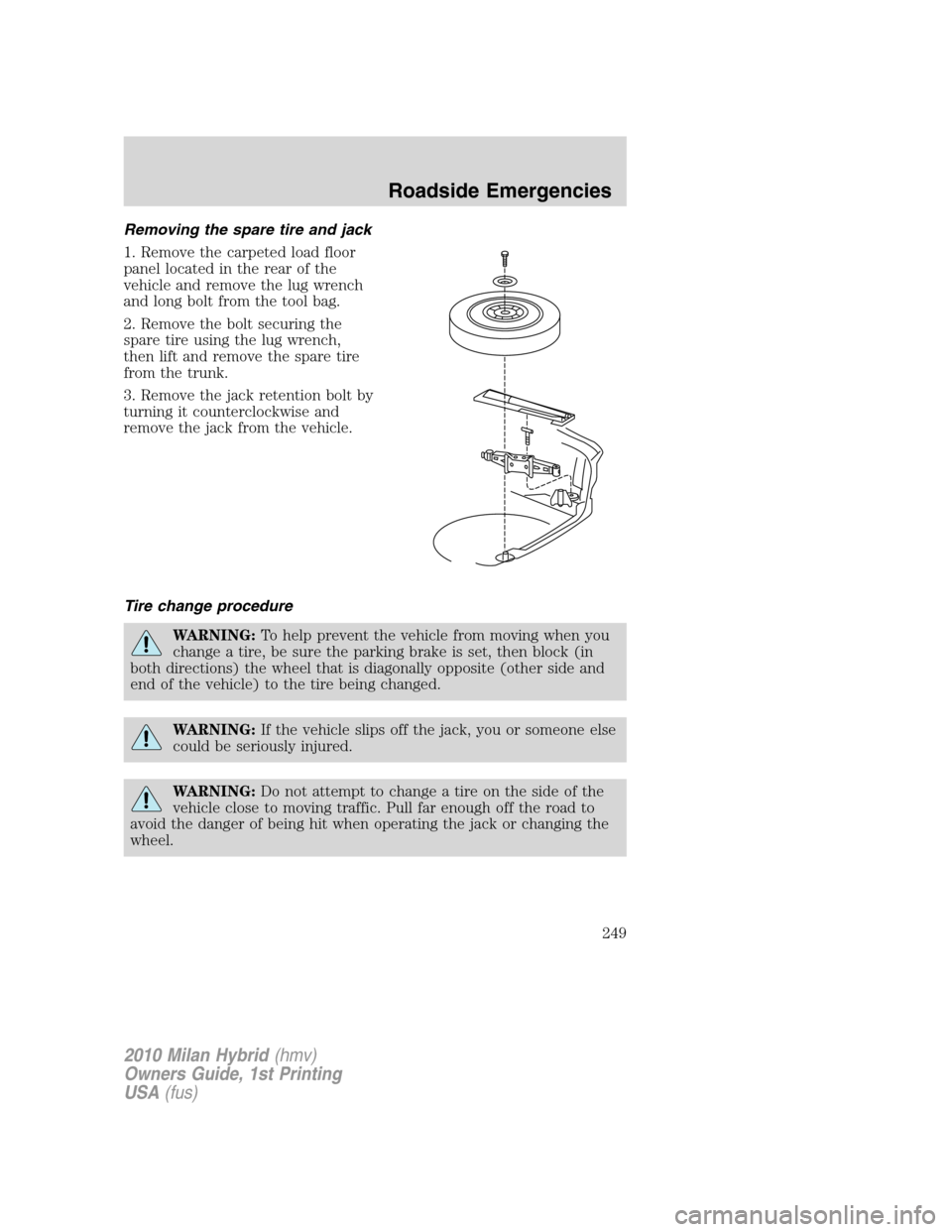
Removing the spare tire and jack
1. Remove the carpeted load floor
panel located in the rear of the
vehicle and remove the lug wrench
and long bolt from the tool bag.
2. Remove the bolt securing the
spare tire using the lug wrench,
then lift and remove the spare tire
from the trunk.
3. Remove the jack retention bolt by
turning it counterclockwise and
remove the jack from the vehicle.
Tire change procedure
WARNING:To help prevent the vehicle from moving when you
change a tire, be sure the parking brake is set, then block (in
both directions) the wheel that is diagonally opposite (other side and
end of the vehicle) to the tire being changed.
WARNING:If the vehicle slips off the jack, you or someone else
could be seriously injured.
WARNING:Do not attempt to change a tire on the side of the
vehicle close to moving traffic. Pull far enough off the road to
avoid the danger of being hit when operating the jack or changing the
wheel.
2010 Milan Hybrid(hmv)
Owners Guide, 1st Printing
USA(fus)
Roadside Emergencies
249